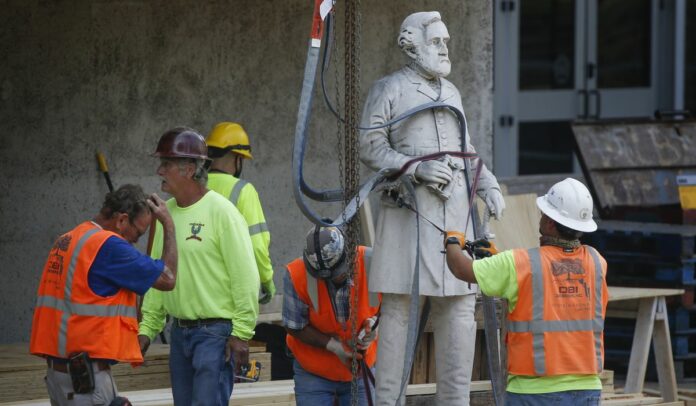ANALYSIS/OPINION:
Confederate statues are coming down across the country as Americans grapple with national conversations about racism in the wake of George Floyd’s death at the hands of a Minneapolis policeman.
By the weekend of June 19 (Juneteenth), when Americans celebrate the emancipation of the last slaves in 1865, calls for systemic change in policing now also encompass the 1,747 monuments, place names and other public symbols that honor the Confederacy — including cemeteries, portraits and the names of U.S. Army installations.
Controversies surrounding Confederate monuments aren’t new, but this time, something feels different. A new Quinnipiac University poll even found that a slim but significant majority of Americans, 52%, now support removing Confederate statues.
In response, President Trump announced Tuesday that he plans to issue an executive order to “make the cities guard their monuments” against the specter of a left-wing mob. The order would be in keeping with Mr. Trump’s poor track record on race, but it would also strip state and municipal governments of the chance to address this moment in their own way.
In the past and at present, conservatives like Mr. Trump have argued against removing Confederate statues, claiming that it “erases” the country’s history. But taking down statues that venerate white supremacists is not at all the same thing as burning books. The facts of American history are unchangeable, but not every piece of history deserves a venerable monument in the public square.
As historian Stephanie McCurry recently wrote, the Confederacy was “an explicitly white-supremacist, pro-slavery, and antidemocratic nation-state, dedicated to the principle that all men are not created equal.” To defend Confederate statues today also ignores that undeniably wicked legacy and, indeed, makes one a party to it.
The claim that removing Confederate monuments erases American history fails to grasp an important distinction between statues in places of public prominence and the stories we tell ourselves about the past. Simply put, regardless of which statues are placed upon pedestals, the historical record — and how it’s taught — is entirely separate.
As Annette Gordon-Reed, a Pulitzer-Prize winning historian of law at Harvard, explained in a recent interview, “History will still be taught. We will know who Robert E. Lee was. Who Jefferson Davis was. […] There are far more dangerous threats to history. Defunding the humanities, cutting history classes and departments. Those are the real threats to history.”
Those threats abound, but Ms. Gordon-Reed’s broader point is that America’s people — and its historians in particular — are not so forgetful and ignorant as reactionary arguments make them out to be. Indeed, calls for removal do not mean that Confederate statues will be thrown down Orwell’s memory hole.
History is not so malleable.
It’s no small irony, then, that the Trump administration has time and again expressed revisionist attitudes toward history. In mid-May, for example, when CBS’ Catherine Herridge asked Attorney General William Barr to explain how historians will describe his decision to dismiss all charges against former National Security Adviser Michael Flynn, Mr. Barr sidestepped the question and quipped, “Well, history is written by the winners, so it largely depends on who’s writing the history.”
Mr. Barr’s comments reveal the Trump administration’s hypocrisy while also clarifying a broader point: If history was written by the winners, then why on Earth would the winners permit statues of Confederate losers to stand in public squares? In reality, it is historians (winners in their own right but also professional scholars equipped to examine the past) who write histories — and, as I’m sure all historians can attest, having Confederate statues in places of public prominence is decidedly not a prerequisite for the writing process.
The question of what statues communities should celebrate and commemorate in public spaces — often by literally putting people on pedestals — is a less complicated question. Confederate statues represent men who fought to tear the Union asunder by maintaining a racialized caste system in which countless men and women were denied the very rights declared unalienable in the American founding.
What is more, many of these statues were constructed alongside Jim Crow laws and civil rights tensions as monuments to white supremacy. This is a horrific fact of our history, but it is recent history: older African-Americans can still recall their grandparents’ firsthand accounts of slavery, descendants of slave ship survivors are still sharing their ancestors’ stories.
History, which we are prone to think of as the past, is ever-present with us today; as James Baldwin wrote, “people are trapped in history and history is trapped in them.”
Today, then, we are faced with the challenge of reimagining how our history should be commemorated in public spaces. Crucially, it’s left to communities to decide which historical figures to celebrate: No statue, once erected, is entitled to stand forever.
Rather than upholding statues that honor the failed Confederacy’s racism, today citizens can draw from history to design new monuments that celebrate the black community’s brilliance and resilience. Communities responding to this moment will make history, I only hope they do for the right reasons.
• Jacob Bruggeman is a current graduate student in history at the University of Cambridge, an incoming Ph.D. student in history at Johns Hopkins University, and a contributor at Young Voices. You can follow him on Twitter @jacob_bruggeman.






